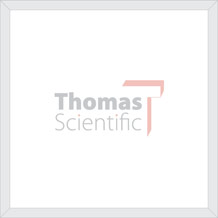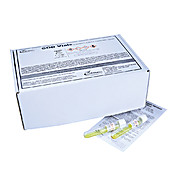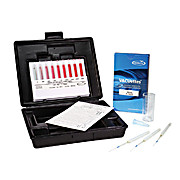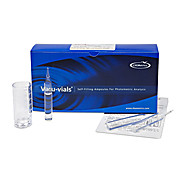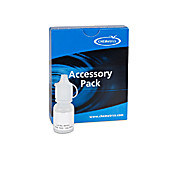CHEMetrics
-
Iron (Total & Ferrous) Vacu-vials Kit
CHEMetricsIron is present in nature in the form of its oxides, or in combination with silicon or sulfur. The soluble iron content of surface waters rarely exceeds 1 mg/L, while ground waters often contain higher concentrations. The National Secondary Drinking Water Standard for iron is 0.3 mg/L, as iron…
-
Phosphate Vacu-vials® Kits
CHEMetricsPhosphorus occurs naturally in rock formations in the earth's crust, usually as phosphate. High phosphate concentrations in surface waters may indicate fertilizer runoff, domestic waste discharge, or the presence of industrial effluents or detergents. Although phosphates from these sources are…
-
Ammonia Vacu-vials Kit, Range: 0-14.0 ppm
CHEMetricsLow-level ammonia nitrogen may be naturally present in water as a result of the biological decay of plant and animal matter. Higher concentrations in surface waters can indicate contamination from waste treatment facilities, raw sewage, industrial effluents (particularly from petroleum refineries),…
-
Glycol CHEMets Kit
CHEMetricsEthylene glycol and propylene glycol are the primary ingredients in commercially-available antifreezes. They are used with various corrosion inhibitors to protect metal surfaces in cooling water systems. CHEMetrics glycol kits are used to monitor potable waters for glycol contamination…
-
Hydrazine CHEMets Kit
CHEMetricsHydrazine is a powerful reducing agent that is used in various chemical processes and in boiler water as an oxygen scavenger. To control corrosion, residual hydrazine typically is maintained in the 0.05 to 0.1 mg/L range. Higher levels may be used to guard against corrosion when the boiler is out…
-
Test Kit
CHEMetricsThe CHEMetrics peracetic acid CHEMets kit and peracetic acid comparator are used to determine various levels of peracetic acid in liquids. These are easy to use and ensure accurate testing. Application: For the Analysis of Peracetic Acid
-
 COD Analysis Kits
CHEMetrics
COD Analysis Kits
CHEMetricsUSEPA-approved Mercury-free COD kits CHEMetrics’ leakproof reagent vials contain premeasured solutions of sulfuric acids and potassium dichromate. To perform the COD determination, the analyst simply removes the Teflon® lined screw cap from the vial, adds sample to the vial,…
-
Nitrate CHEMets Kit, Range: 0-3.4 ppm
CHEMetricsNitrate is the most completely oxidized form of nitrogen. It is formed during the final stages of biological decomposition, either in wastewater treatment facilities or in natural water supplies. Low-level nitrate concentrations may be present in natural waters. However, a Maximum Contaminant Level…
-
COD VIALS MERC FREE 98VIALS UN 1830
CHEMetricsKit comes in a cardboard box and contains everything needed to perform up to 97 tests (except distilled water): 98 vials and instruction book. Range: 0-15,000 ppm (HR+) Mercury Free Method: APHA Standard Methods, 23rd ed., Method 3500-Cu C-1999. All COD Kits require the use…
-
Bromine CHEMets Kit
CHEMetricsBromine, a less volatile compound than chlorine, is used as a sanitizing agent in drinking water systems, swimming pools, and spas. The bromine test method employs the DPD chemistry. Potassium iodide is added to the sample before analysis. Bromine reacts with the iodide to liberate iodine. The…
-
The accessory pack supplies enough solution to perform at least 200 tests.
-
Cyanide (Free) CHEMets Kit
CHEMetricsCyanide is used in many chemical and refining processes. It is found in effluent from electroplating and metal cleaning operations, coke ovens, steel manufacturing facilities, and gas scrubbers. Although cyanide can be safely removed by alkaline chlorination, its acute toxicity to aquatic life…
-
Molybdate CHEMets Kit, Range: 0-7 ppm
CHEMetricsMolybdate is used throughout the industrial water treatment and power generation industries as a corrosion inhibitor in both open- and closed-loop cooling water systems. In solution, molybdate anions complex with oxidized iron to form a protective film of molybdate and ferric-oxide. Molybdate is…
-
WARNING! This product can expose you to chemicals including ethylene glycol, which is known to the State of California to cause birth defects or other reproductive harm. For more information go to www.P65Warnings.ca.gov .
-
Sulfate - Vacu-vials Instrumental Kit
CHEMetricsThe CHEMetrics vacu-vials instrumental kit is an ideal thing to have in any chemical laboratories, healthcare units or medicinal facilities for a wide range of purposes such as scientific research and development.
-
Because of its strong oxidizing properties, chlorine is an excellent biocide used to treat potable waters, municipal wastes, and swimming pools. When used to treat potable water, chlorine helps alleviate the adverse effects of iron, manganese, ammonia, and sulfide. The Maximum Residual Disinfectant…
-
Range: 250-2500 ppm as NaNO2 MDL: 250 ppm Method: Ceric Sulfate Titrant with Ferroin Indicator Increments: 250, 275, 300, 325, 350, 375, 400, 450, 500, 625, 750, 875, 1000, 1250, 1750, 2500 ppm Kit comes in a cardboard box and contains everything needed to perform 30…
-
 Chlorine (Free & Total) CHEMets® Kits
CHEMetrics
Chlorine (Free & Total) CHEMets® Kits
CHEMetricsBecause of its strong oxidizing properties, chlorine is an excellent biocide used to treat potable waters, municipal wastes, and swimming pools. When used to treat potable water, chlorine helps alleviate the adverse effects of iron, manganese, ammonia, and sulfide. The Maximum Residual Disinfectant…
-
Nitrate Vacu-vials Kit, Range: 0-50.0 ppm
CHEMetricsNitrate is the most completely oxidized form of nitrogen. It is formed during the final stages of biological decomposition, either in wastewater treatment facilities or in natural water supplies. Low-level nitrate concentrations may be present in natural waters. However, a Maximum Contaminant Level…
-
Iron VACUettes Refill
CHEMetricsThis product contains 30 self-filling VACUettes ampoules to refill kit K-6210D for the analysis of iron (total & ferrous). R-6201D is compatible with C-6001D and C-6010D comparators.
-
Iron CHEMets Kit
CHEMetricsIron is present in nature in the form of its oxides, or in combination with silicon or sulfur. The soluble iron content of surface waters rarely exceeds 1 mg/L, while ground waters often contain higher concentrations. The National Secondary Drinking Water Standard for iron is 0.3 mg/L, as iron…
-
Hydrogen peroxide is a strong oxidizing agent with a variety of uses. Applications include the treating of industrial effluents and domestic waste and serving as a disinfectant in aseptic packaging. The Ferric Thiocyanate Method Reference: D. F. Boltz and J. A. Howell, eds.,…
-
Chloride Titrets® Test Kits
CHEMetricsChloride is the most common inorganic anion found in water and wastewater. The Maximum Secondary Contaminant Level for drinking water for chloride is 250 mg/L. Natural sources of salt are the ocean and various salt deposits above and below ground. Chloride is very corrosive to most metals in…
-
 Dissolved Oxygen CHEMets® Kits
CHEMetrics
Dissolved Oxygen CHEMets® Kits
CHEMetricsThe level of dissolved oxygen in natural waters is often a direct indication of quality, since aquatic plants produce oxygen, while microorganisms generally consume it as they feed on pollutants. At low temperatures the solubility of oxygen is increased; during summer, saturation levels can be as…
-
Kit comes in a plastic case and contains everything needed to perform 30 tests (except distilled water): Refill, Low and High Range Comparators, dilutor snapper cup, micro test tube, and instructions. Range: 0-60 & 60-600 ppm MDL: 10 ppm Method: Direct Nesslerization …
-
Sulfide Comparator
CHEMetricsThe CHEMetrics sulfide comparator is an ideal thing to have in any chemical laboratories, medicinal facilities or healthcare units for a wide range of purposes such as scientific research and development.
-
Phenols VACUettes® Kits
CHEMetricsPhenol (hydroxybenzene) is the simplest of a group of similar organic chemicals, which includes cresols, xylenols, and catechols. Phenol itself is a common ingredient of disinfectants. In drinking water, low-level phenolic concentrations impart a foul taste and odor, especially upon chlorination.…
-
The accessory pack supplies enough solution to perform at least 200 tests.
-
Detergents CHEMets Kit, Range: 0-3 ppm
CHEMetricsDetergents can be introduced into the water supply by industry, soap manufacturers, and private households. Environmental analysts often include a determination of anionic detergents when assessing surface water pollution. The Methylene Blue Method References: USEPA Methods for…
-
Ozone Vacu-vials Kit
CHEMetricsOzone is a strong oxidizing agent and is used as an alternative to chlorine as a biocide in the disinfection of drinking water. Ozone is used to remove odor, decolorize, and to control algae and other aquatic growths. Ozone is also used in various disinfectant and sterilization processes in…
-
Ozone CHEMets Kit
CHEMetricsOzone is a strong oxidizing agent and is used as an alternative to chlorine as a biocide in the disinfection of drinking water. Ozone is used to remove odor, decolorize, and to control algae and other aquatic growths. Ozone is also used in various disinfectant and sterilization processes in…
-
Kit comes in a plastic case and contains everything needed to perform 30 tests (except distilled water): Refill, Low and High Range Comparators, dilutor snapper cup, micro test tube, and instructions. Range: 0-30 & 30-300 ppm MDL: 5 ppm Method: Direct Nesslerization …








